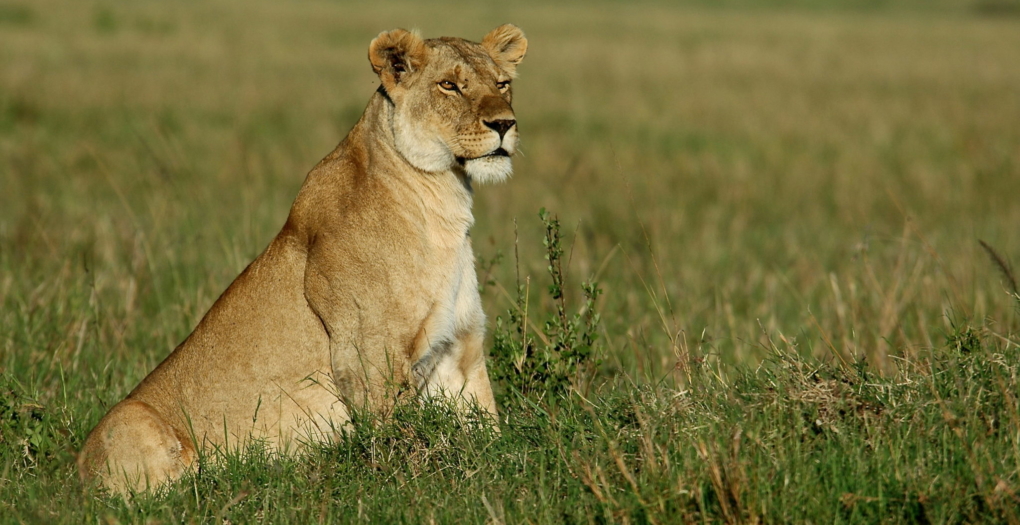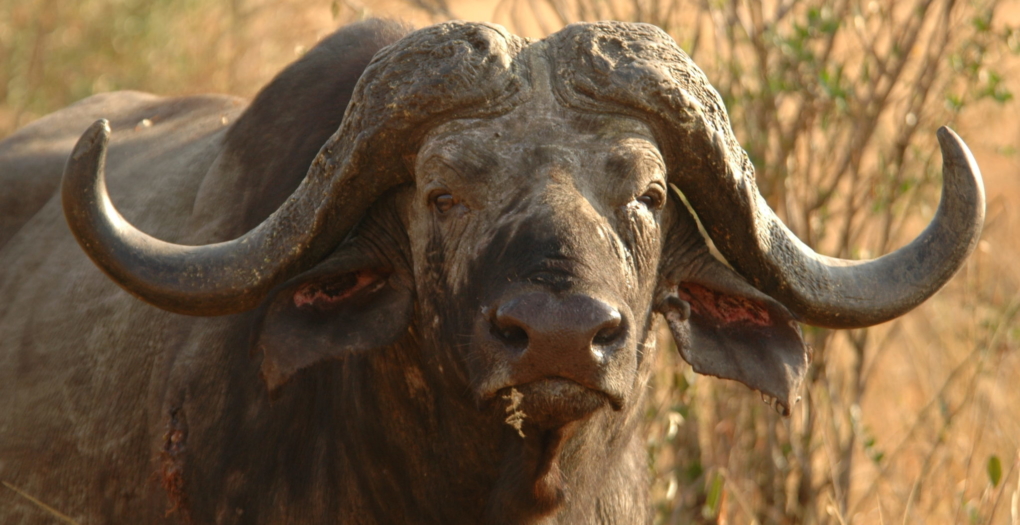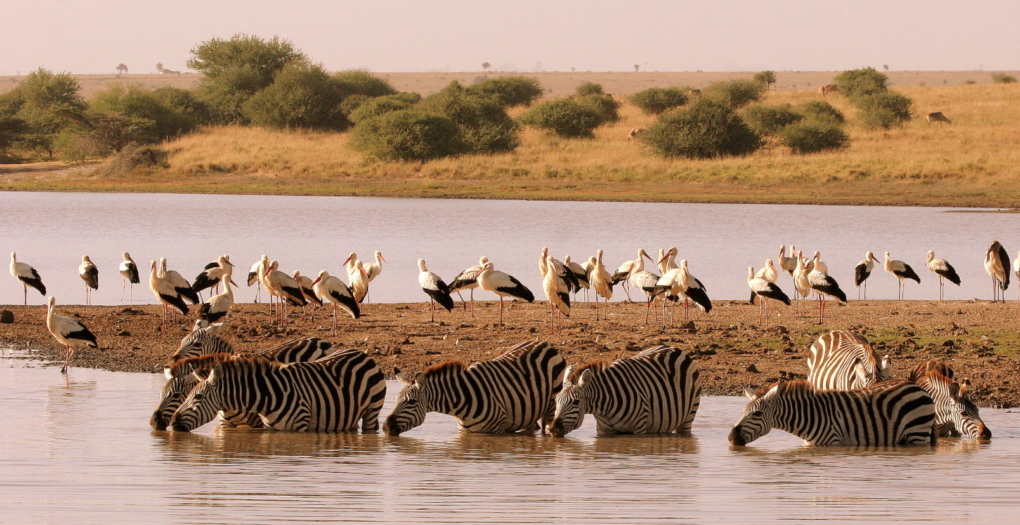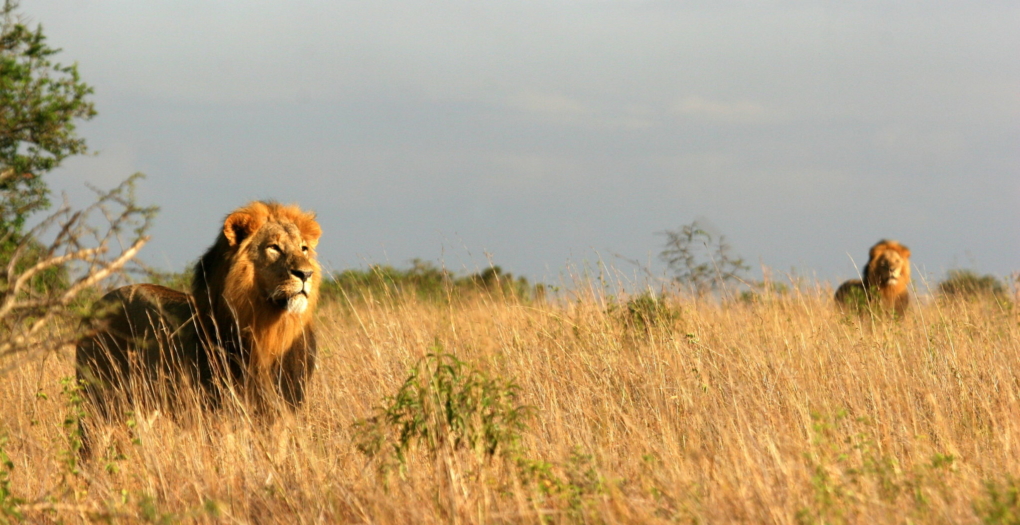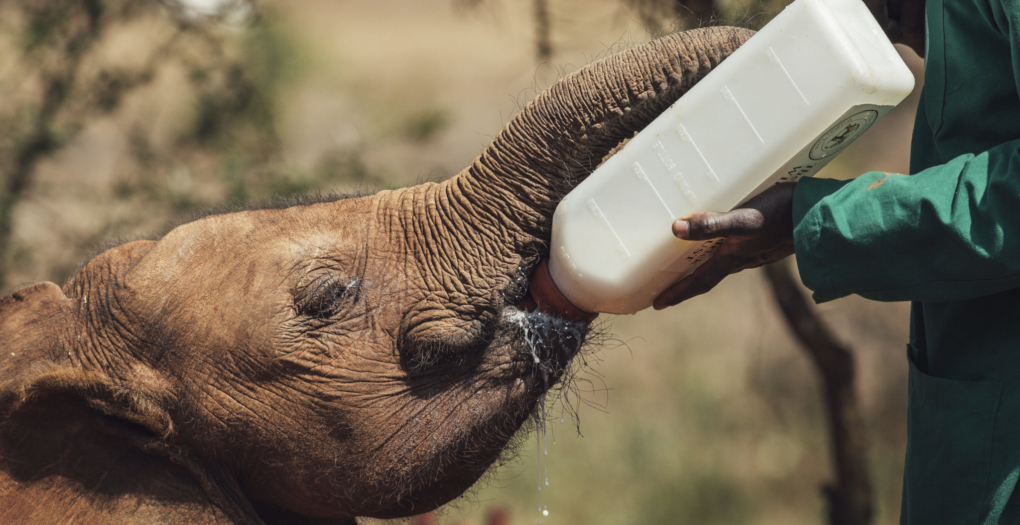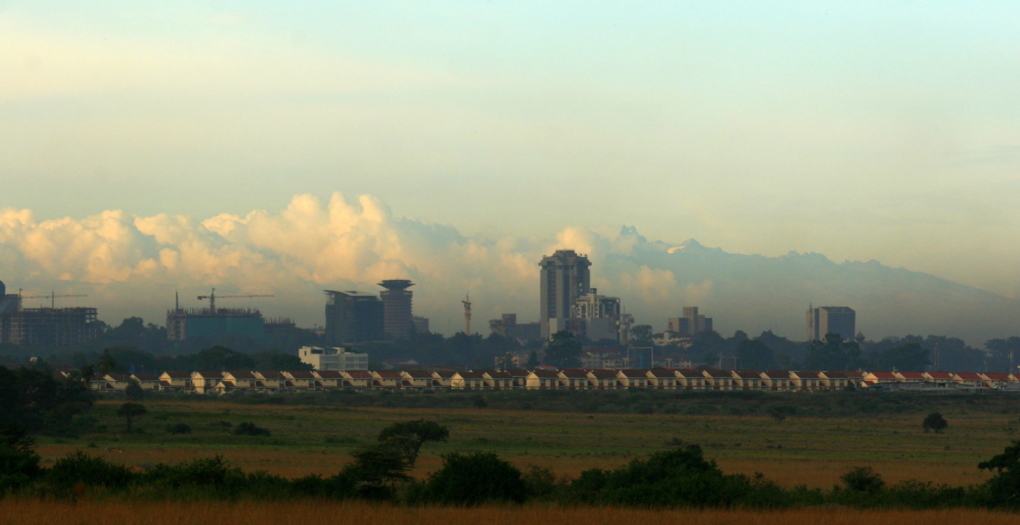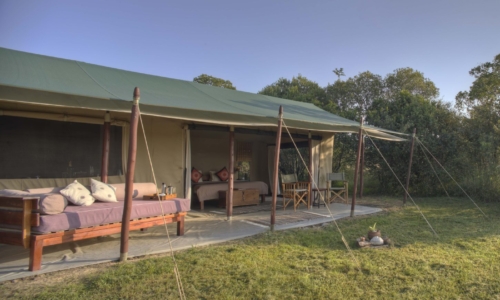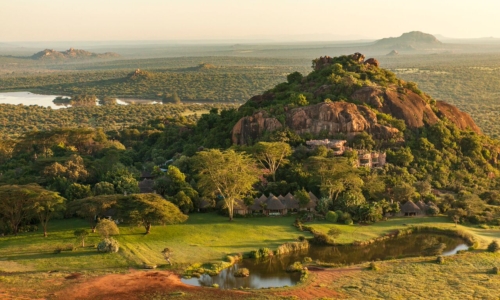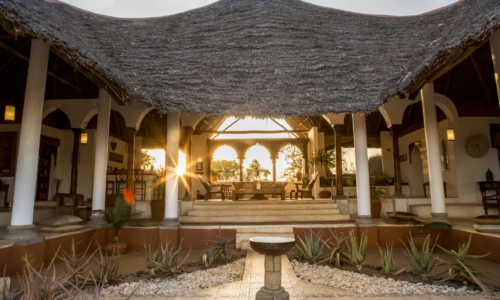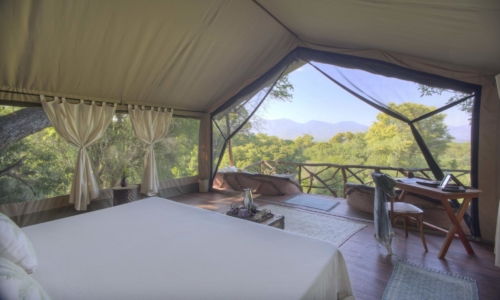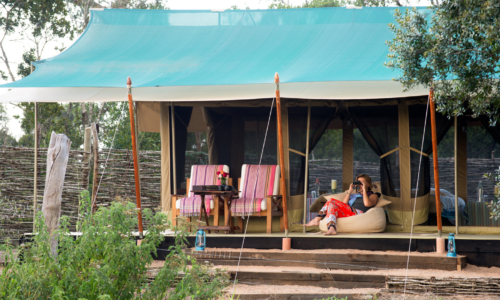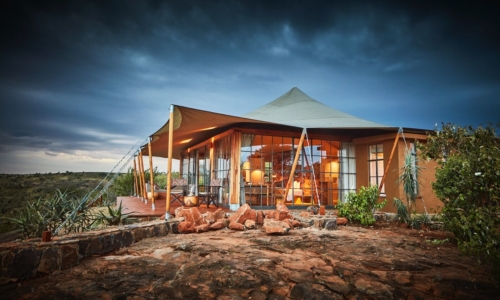Established in 1946, Nairobi National Park is the first national park in Kenya and it encompasses 28,963 acres of land. It is only four miles south of the heart of the city with an electric fence separating the animals from the busy metropolis. In fact, Nairobi’s skyscrapers can be seen gracing the skyline behind the park making for some amazing photographs since it is the only natural safari park that has a cityscape background. On its southern border, the park is bound by the Mbagathi River which is unfenced and open to the Kitengela Conservation Area. The park has a wide range of habitats though it is predominately made up of open grass plains but also includes riverine forest, highland dry forests, and deep rocky valleys and gorges.
The park has a wide variety of animals found within its borders including one hundred mammal species. Some of the wildlife found here include Cape buffaloes, baboons, black rhinos, gazelles, cheetah, hartebeest, leopards, Masai lions, elands, impala, giraffes, waterbucks, and many more. Grazing animals including wildebeest and zebras use the Kitengela Conservation area to migrate through to the Athi-Kapiti plains.
The best time to view the abundant wildlife here is during the dry season when all other water sources have dried up. There are a multitude of bird species who live and pass through the region with up to 500 permanent and migratory species. The dams have attracted many birds, especially waterfowl to the area. The David Sheldrick Trust operates a sanctuary in the park for orphan elephants and rhino calves. These baby animals are hand-reared and then released into secure sanctuaries.
Nairobi National Park is a big tourist draw for the city of Nairobi. In July and August, visitors come to watch the wildebeest and zebra migration. The Park’s Wildlife Conservation Education Center hosts lectures and videos about the resident animals as well as guided tours of the park grounds and orphanage. However, game drives are the best way to explore the park. But there are also many walking trails and five designated picnic spots. Bird watching is a popular pastime with so many species to view. Bush dinners are a delicious way to obverse the abundant wildlife while enjoying a great meal.


- Amboseli Serena Safari Lodge
- Basecamp Masai Mara
- Bateleur Camp
- Campi ya Kanzi
- Cottar’s 1920s Safari Camp
- Deloraine House
- Eagle View
- Elephant Bedroom Camp
- Elephant Pepper Camp
- Elsa’s Kopje
- Emboo
- Encounter Mara
- Governors’ Camp
- Governors’ Private Camp
- Hemingways Ol Seki Mara Camp
- House in the Wild
- Il Moran Camp
- Il Ngwesi
- Joy’s Camp
- Kicheche Bush
- Kicheche Laikipia
- Kicheche Mara
- Kicheche Valley
- Kichwa Tembo Tented Camp
- Kifaru House Lewa
- Kilaguni Serena Safari Lodge
- Kinondo Kwetu
- Kitich Camp
- Kitirua Plains Lodge
- Lake Elmenteita Serena Camp
- Leopard Hill
- Lewa House
- Lewa Private Wilderness
- Lewa Safari Camp
- Lewa Wilderness Lodge
- Little Governors’ Camp
- Loisaba Lodo Springs
- Loisaba Star Beds
- Loisaba Tented Camp
- Loldia House
- Mahali Mzuri
- Mara Expedition Camp
- Mara Nyika
- Mara Plains Camp
- Mara Serena Safari Lodge
- Mara Toto Tree Camp
- Mfangano Island Camp
- Naboisho Camp
- Ngare Serian
- Offbeat Mara Camp
- Ol Donyo Lodge
- Ol Jogi
- Ol Pejeta Bush Camp
- Ol Pejeta House
- Olare Mara
- Ololo Safari Lodge
- Olonana
- Olonana – Geoffrey Kent Suite
- Rekero Camp
- Reteti House
- Sabuk Lodge
- Sala’s Camp
- Sand River Masai Mara
- Sarara Camp
- Sarara Treehouses
- Sarara Wilderness
- Saruni Mara
- Saruni Rhino
- Saruni Samburu
- Saruni Wild
- Sasaab Camp
- Segera Retreat
- Serian The Original
- Serian’s Nkorombo
- Sirikoi
- Solio Lodge
- Sosian Lodge
- Speke’s Camp
- Tambarare
- Tangulia Mara
- Tawi Lodge
- Tortilis Camp
- Wilderness Mara
- Amboseli Serena Safari Lodge
- Basecamp Masai Mara
- Bateleur Camp
- Campi ya Kanzi
- Cottar’s 1920s Safari Camp
- Deloraine House
- Eagle View
- Elephant Bedroom Camp
- Elephant Pepper Camp
- Elsa’s Kopje
- Emboo
- Encounter Mara
- Governors’ Camp
- Governors’ Private Camp
- Hemingways Ol Seki Mara Camp
- House in the Wild
- Il Moran Camp
- Il Ngwesi
- Joy’s Camp
- Kicheche Bush
- Kicheche Laikipia
- Kicheche Mara
- Kicheche Valley
- Kichwa Tembo Tented Camp
- Kifaru House Lewa
- Kilaguni Serena Safari Lodge
- Kinondo Kwetu
- Kitich Camp
- Kitirua Plains Lodge
- Lake Elmenteita Serena Camp
- Leopard Hill
- Lewa House
- Lewa Private Wilderness
- Lewa Safari Camp
- Lewa Wilderness Lodge
- Little Governors’ Camp
- Loisaba Lodo Springs
- Loisaba Star Beds
- Loisaba Tented Camp
- Loldia House
- Mahali Mzuri
- Mara Expedition Camp
- Mara Nyika
- Mara Plains Camp
- Mara Serena Safari Lodge
- Mara Toto Tree Camp
- Mfangano Island Camp
- Naboisho Camp
- Ngare Serian
- Offbeat Mara Camp
- Ol Donyo Lodge
- Ol Jogi
- Ol Pejeta Bush Camp
- Ol Pejeta House
- Olare Mara
- Ololo Safari Lodge
- Olonana
- Olonana – Geoffrey Kent Suite
- Rekero Camp
- Reteti House
- Sabuk Lodge
- Sala’s Camp
- Sand River Masai Mara
- Sarara Camp
- Sarara Treehouses
- Sarara Wilderness
- Saruni Mara
- Saruni Rhino
- Saruni Samburu
- Saruni Wild
- Sasaab Camp
- Segera Retreat
- Serian The Original
- Serian’s Nkorombo
- Sirikoi
- Solio Lodge
- Sosian Lodge
- Speke’s Camp
- Tambarare
- Tangulia Mara
- Tawi Lodge
- Tortilis Camp
- Wilderness Mara

Established in 1946, Nairobi National Park is the first national park in Kenya and it encompasses 28,963 acres of land. It is only four miles south of the heart of the city with an electric fence separating the animals from the busy metropolis. In fact, Nairobi’s skyscrapers can be seen gracing the skyline behind the park making for some amazing photographs since it is the only natural safari park that has a cityscape background. On its southern border, the park is bound by the Mbagathi River which is unfenced and open to the Kitengela Conservation Area. The park has a wide range of habitats though it is predominately made up of open grass plains but also includes riverine forest, highland dry forests, and deep rocky valleys and gorges.
The park has a wide variety of animals found within its borders including one hundred mammal species. Some of the wildlife found here include Cape buffaloes, baboons, black rhinos, gazelles, cheetah, hartebeest, leopards, Masai lions, elands, impala, giraffes, waterbucks, and many more. Grazing animals including wildebeest and zebras use the Kitengela Conservation area to migrate through to the Athi-Kapiti plains.
The best time to view the abundant wildlife here is during the dry season when all other water sources have dried up. There are a multitude of bird species who live and pass through the region with up to 500 permanent and migratory species. The dams have attracted many birds, especially waterfowl to the area. The David Sheldrick Trust operates a sanctuary in the park for orphan elephants and rhino calves. These baby animals are hand-reared and then released into secure sanctuaries.
Nairobi National Park is a big tourist draw for the city of Nairobi. In July and August, visitors come to watch the wildebeest and zebra migration. The Park’s Wildlife Conservation Education Center hosts lectures and videos about the resident animals as well as guided tours of the park grounds and orphanage. However, game drives are the best way to explore the park. But there are also many walking trails and five designated picnic spots. Bird watching is a popular pastime with so many species to view. Bush dinners are a delicious way to obverse the abundant wildlife while enjoying a great meal.

- Amboseli Serena Safari Lodge
- Basecamp Masai Mara
- Bateleur Camp
- Campi ya Kanzi
- Cottar’s 1920s Safari Camp
- Deloraine House
- Eagle View
- Elephant Bedroom Camp
- Elephant Pepper Camp
- Elsa’s Kopje
- Emboo
- Encounter Mara
- Governors’ Camp
- Governors’ Private Camp
- Hemingways Ol Seki Mara Camp
- House in the Wild
- Il Moran Camp
- Il Ngwesi
- Joy’s Camp
- Kicheche Bush
- Kicheche Laikipia
- Kicheche Mara
- Kicheche Valley
- Kichwa Tembo Tented Camp
- Kifaru House Lewa
- Kilaguni Serena Safari Lodge
- Kinondo Kwetu
- Kitich Camp
- Kitirua Plains Lodge
- Lake Elmenteita Serena Camp
- Leopard Hill
- Lewa House
- Lewa Private Wilderness
- Lewa Safari Camp
- Lewa Wilderness Lodge
- Little Governors’ Camp
- Loisaba Lodo Springs
- Loisaba Star Beds
- Loisaba Tented Camp
- Loldia House
- Mahali Mzuri
- Mara Expedition Camp
- Mara Nyika
- Mara Plains Camp
- Mara Serena Safari Lodge
- Mara Toto Tree Camp
- Mfangano Island Camp
- Naboisho Camp
- Ngare Serian
- Offbeat Mara Camp
- Ol Donyo Lodge
- Ol Jogi
- Ol Pejeta Bush Camp
- Ol Pejeta House
- Olare Mara
- Ololo Safari Lodge
- Olonana
- Olonana – Geoffrey Kent Suite
- Rekero Camp
- Reteti House
- Sabuk Lodge
- Sala’s Camp
- Sand River Masai Mara
- Sarara Camp
- Sarara Treehouses
- Sarara Wilderness
- Saruni Mara
- Saruni Rhino
- Saruni Samburu
- Saruni Wild
- Sasaab Camp
- Segera Retreat
- Serian The Original
- Serian’s Nkorombo
- Sirikoi
- Solio Lodge
- Sosian Lodge
- Speke’s Camp
- Tambarare
- Tangulia Mara
- Tawi Lodge
- Tortilis Camp
- Wilderness Mara
- Amboseli Serena Safari Lodge
- Basecamp Masai Mara
- Bateleur Camp
- Campi ya Kanzi
- Cottar’s 1920s Safari Camp
- Deloraine House
- Eagle View
- Elephant Bedroom Camp
- Elephant Pepper Camp
- Elsa’s Kopje
- Emboo
- Encounter Mara
- Governors’ Camp
- Governors’ Private Camp
- Hemingways Ol Seki Mara Camp
- House in the Wild
- Il Moran Camp
- Il Ngwesi
- Joy’s Camp
- Kicheche Bush
- Kicheche Laikipia
- Kicheche Mara
- Kicheche Valley
- Kichwa Tembo Tented Camp
- Kifaru House Lewa
- Kilaguni Serena Safari Lodge
- Kinondo Kwetu
- Kitich Camp
- Kitirua Plains Lodge
- Lake Elmenteita Serena Camp
- Leopard Hill
- Lewa House
- Lewa Private Wilderness
- Lewa Safari Camp
- Lewa Wilderness Lodge
- Little Governors’ Camp
- Loisaba Lodo Springs
- Loisaba Star Beds
- Loisaba Tented Camp
- Loldia House
- Mahali Mzuri
- Mara Expedition Camp
- Mara Nyika
- Mara Plains Camp
- Mara Serena Safari Lodge
- Mara Toto Tree Camp
- Mfangano Island Camp
- Naboisho Camp
- Ngare Serian
- Offbeat Mara Camp
- Ol Donyo Lodge
- Ol Jogi
- Ol Pejeta Bush Camp
- Ol Pejeta House
- Olare Mara
- Ololo Safari Lodge
- Olonana
- Olonana – Geoffrey Kent Suite
- Rekero Camp
- Reteti House
- Sabuk Lodge
- Sala’s Camp
- Sand River Masai Mara
- Sarara Camp
- Sarara Treehouses
- Sarara Wilderness
- Saruni Mara
- Saruni Rhino
- Saruni Samburu
- Saruni Wild
- Sasaab Camp
- Segera Retreat
- Serian The Original
- Serian’s Nkorombo
- Sirikoi
- Solio Lodge
- Sosian Lodge
- Speke’s Camp
- Tambarare
- Tangulia Mara
- Tawi Lodge
- Tortilis Camp
- Wilderness Mara







